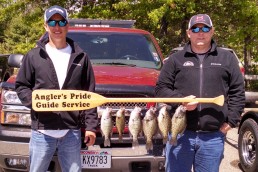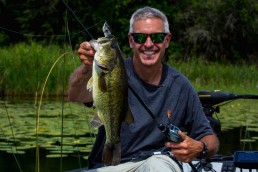Shallow Weed Tactics for Untapped Largemouths
SHARE THIS POST
Bass fishing popularity is growing by leaps and bounds. More people fish for largemouth bass than all other gamefish species combined. Largemouth bass are a great sport fish and are found in most bodies of water throughout the Midwest. Lakes, rivers, reservoirs, pits and ponds all hold this great battler. They like many of different habitats and can be caught in a variety of areas with various techniques.
One area and technique that still to this day gets little attention is shallow heavy-weed slop fishing. When you walk down the aisles of your favorite fishing retailers there are many topwater frogs and other baits for slop fishing. But back on the water you see very few anglers actually hitting the heavy slop cover with frogs or other heavy cover techniques. Some anglers will hit the fringe areas and then leave for greener pastures.
In years past, trolling motor technology was not up to handling heavy weed cover. They used to sell a basket style cover that you would mount behind the prop. This would only marginally help getting through the weeds. Today, weedless trolling motor props will chop through the heaviest weeds without blowing fuses or circuit breakers. You might have to pull some heavy weeds off the shaft of the trolling motor, but a little bit of work is worth it when you can catch some quality unpressured bass. When purchasing a trolling motor for your boat, always get the most powerful motor you can afford with a long enough shaft, so the prop will stay in the water, even in big waves. Twenty-four volt trolling motors are the most popular with power up to about 80 pounds thrust. If you have room for a third battery, the 36-volt trolling motor is the most powerful with pounds of thrust exceeding 100 pounds. The nice thing about powerful trolling motors is that on a normal day with average winds, you can keep your motor on a lower setting; this extends the life of your batteries. Although not recommended, you can go three days without recharging your batteries.
While targeting bass in shallow slop weeds, there is a standard procedure that will get you the maximum number of fish. Work from the outside in. Start by targeting the outer fringe weeds. Buzzbaits, weedless spoons like the Johnson Silver Minnow, The Norman Weed Walker and floating toad-style lures with kicking legs are all great baits to cover water. Buzzbaits are now coming with plastic toads instead of skirts, to attract even more attention with a much louder noise and water displacement. Catch those outside fish first. If you get a blow-up and miss the fish, have a second rod rigged with a throw-back bait. A Texas-rigged Senko style bait is an awesome throw-back bait and will catch a lot of fish that miss your first more aggressive presentation.
When you catch all the fish you can from the outside fringe weeds you are now ready to move into the heavier cover. The topwater frog is a great tool for catching bass in the slop. There are many great weedless frogs on the market. One of the oldest and still one of the best is the Snag Proof Tournament Frog. This frog is soft and designed well with ultra sharp hooks. Other good frogs are made by Spro, Live Target, Strike King, Booyah and Jackall to name a few.
To fish these frogs in heavy cover, you need the right equipment. A heavy-action baitcasting rod is an absolute must. A medium retrieve 6:1 gear ratio reel spooled with 50-, 65- or 80-pound braided line will help you winch big bass from the thick, unforgiving cover. A 7- to-7 1/2-foot rod is ideal for making long casts and covering a lot of water. The hard part is when you get that explosive topwater strike. Your initial reaction is usually to set the hook on the blow-up, which most often results in a missed fish. You need to train yourself to wait until you feel the weight of the fish and then set the hook hard, and pull the fish out of the heavy cover. This style of fishing is very exciting, and it’s a shallow-water winner-take-all situation. You can put some very big fish in the boat. The nicest part of the whole deal is you can have a lot of these areas to yourself.
These slop areas can be large bays, channels, the backs of marinas, coves in reservoirs and back waters in major river systems. The slop doesn’t even have to cover a large area. A small piece of slop in the back corner of a marina can hold a fish or two. Slop coming a couple of feet off a riprap shoreline can hold bunches of fish. A lot of these areas are totally overlooked by the average angler.
There are times when a lot of fish will miss the frogs. Again, a second rod rigged with a throw-back lure can usually get you the fish that missed. A Texas-rigged plastic bait like a worm, Senko, or creature bait is ideal for the situation. Make sure you use a heavy enough weight to penetrate the cover. When a fish blows up and misses your frog he usually creates a hole in the slop. With a little casting accuracy, pitch that throw back bait right in the hole—more often than not, you can catch that fish.
There will be days when the fish won’t be active enough to hit your topwater frog. They have not left the area but they usually hunker down at the base of the weed growth. Sometimes, an effect such as a cold front can cause the fish to be in a neutral or negative mood. This doesn’t mean that they can’t be caught, but that a change in presentation is in order. A technique called “punching” can cause a reaction strike, making the fish hit.
Are you enjoying this post?
You can be among the first to get the latest info on where to go, what to use and how to use it!
The punching technique is simply taking a Texas-rigged beaver-style bait with a heavy tungsten weight and dropping it quickly through the heavy canopy to the bottom. They call this punching through the slop. The quick falling bait to the bottom can cause a reaction strike from a nearby fish. This is the ultimate way to catch fish in a negative mood.
You’re going to need a few special components to get rigged for punching. A heavy action baitcasting rod and reel loaded with 50-pound-plus braid or 20-pound-plus fluorocarbon is ideal. Another option is to use a punch skirt, put on in front of the sinker. Strike King makes a punch skirt, which is a skirted sinker all in one. The hook you want to use is a straight-shaft, rubber coated, heavy-duty flipping style hook. A 4/0 or 5/0 size is ideal. There are several good plastic baits to use for punching. The Strike King Rodent or Structure Bug, the Reaction Innovation’s Sweet Beaver, and the Missile Baits D Bomb are great choices.
You want to use an underhand pitch cast high enough to penetrate the cover. If the cover is super heavy, increase your sinker weight until the bait penetrates through the cover to the bottom. Treat the canopy of cover or lily pad bed like a grid. Hit all areas of the grid thoroughly, so you cover every square foot. Most of the time you have to get the bait right in front of a fish’s face to get a reaction strike. You can cover water quickly with this technique. Pitch the bait out, let it penetrate the cover, jig it in place a couple times, and then pull it out and proceed to the next pitch cast. The hit will most of the time feel like a small tick. If you’re a line watcher you will see the line jump. Set the hook hard, pull the fish up and across the heavy cover back to the boat. This is another exciting way to put big fish in the boat.
Another area where the punching technique works is thick weed flats and pockets. This is a deadly technique that is not used all too often. The same setup will work as far as equipment goes; the only difference is your bait choice. A better choice on weed flats is a higher-action bait. A Zoom Speed Craw or the new Berkley Chigger Bug fits the bill. The legs on these baits pulsate really fast; this causes a good vibration and action that attracts and catches fish. This is a presentation that the fish in the flats are not used to seeing, making it ultra effective. There are days when you can really catch a lot of nice fish—and some really big fish—using this technique.
So next time you’re out bass fishing, hit the slop and heavy cover and you can really catch some big bass in the Strike Zone.
MWO
Phil Piscitello has 45 years of experience as a multispecies angler on ice and open water. He is a fishing guide, master charter captain and seminar speaker guiding in northern Illinois and southern Wisconsin. Piscitello is also a regular guest on Chauncey’s Great Outdoors radio show and MidWest Outdoors TV show. He has fished all five Great Lakes and many major rivers, lakes, and reservoirs throughout the Midwest.
A selection of great slop-fishing baits.
A big bass caught from a heavy lily pad bed.
MWO
SHARE THIS POST
Did you enjoy this post?
You can be among the first to get the latest info on where to go, what to use and how to use it!
Phil Piscitello
Phil Piscitello has 45 years of experience as a multispecies angler on ice and open water. He is a fishing guide, master charter captain and seminar speaker guiding in northern Illinois and southern Wisconsin. Picitello is also a regular guest on Chauncey’s Great Outdoors radio show and MidWest Outdoors TV show. He has fished all five Great Lakes and many major rivers, lakes, and reservoirs throughout the Midwest.



